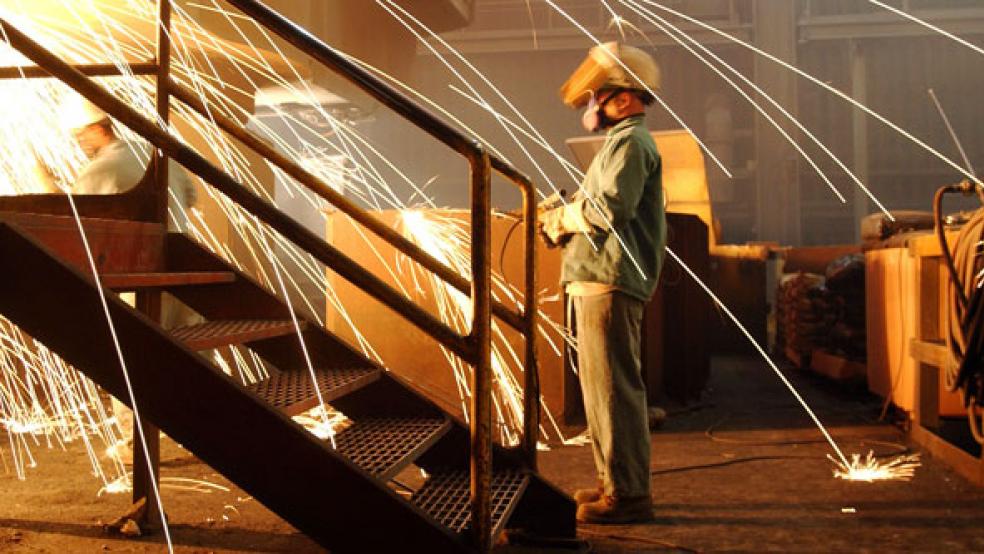In Wamego, Kan., Caterpillar Inc. is doing something that would surprise most people in this depressed economic time: It is adding 40,000 square feet to an already large factory complex to expand production of construction and earthmoving equipment. The project will enable the company to increase its workforce there by about 120, to 500 workers.
Why surprising? Because there’s a widespread misperception that businesses, particularly big ones, are just sitting on huge piles of cash and neither investing it in plants, equipment or software nor hiring additional workers. The lack of hiring is mostly right. The belief that there’s little investment is totally wrong.
Since the middle of last year, business investment in structures, equipment and software has been responsible for half the nation’s economic growth. In the second quarter of this year, the latest figures available, such spending accounted for 1 percentage point of the weak 1.3 percent rate of increase in GDP, the Bureau of Economic Analysis reported last week. In other words, more than three quarters of the growth in the economy in that quarter was due to business investment.
Between June of 2010 and this June, capital expenditures or “capex,” as many analysts call it, surged by 10 percent. No other part of the economy has been nearly so strong. Unfortunately, such spending is only about one-tenth of the total economy and thus cannot by itself lift the country out of its doldrums.
Caterpillar’s August announcement of the Kansas project said the company plans to invest about $3 billion around the world this year to expand its production capacity, “with about half of that invested at its operations in the United States.”
But expanding capacity is not what’s driving most business investment these days, according Jerry Jasinowski, an economist and business consultant who formerly headed the National Association of Manufacturers.
“As I talk to people in manufacturing, they tell me they are not spending it on increases in capacity,” Jasinowski told The Fiscal Times. “They are spending it on maintenance, modernization, software and other things to improve the supply chain. It’s a move to ‘lean’ manufacturing to try to improve operations. Along with exports, that is the thing that has driven manufacturing this year more than anything else.”
Jasinowski expects capex to remain healthy, more so than the overall economy. “I think we are going into a 2 percent growth period or less,” he said, and the executives whom he sees are not looking for anything better.
Economist Robert V. DiClemente of Citigroup has a similar forecast for 2012 -- 2 percent growth with capex rising at about a 5 percent pace, he told his clients last week.
Meanwhile, reports on new orders for durable investment goods, excluding aircraft and defense equipment, showed further strong gains in both July and August. Booming shipments of such goods suggest that “growth in spending on equipment and software in GDP may be running at a 15 percent annual rate this quarter,” DiClemente said.
Macroeconomic Advisers, the St. Louis forecasting firm, has a similar business investment figure in its outlook for next year and an even stronger 8.3 percent gain forecast for 2013.
If those forecasts turn out to be correct, capex will be a steadily rising share of the economy, fostering continued productivity growth.
One factor undoubtedly encouraging businesses to invest more even when overall demand is weak is the ease with which they can obtain financing. That’s not true for smaller businesses unable to tap the bond market. For the most part, such firms have to turn to banks, which in the wake of the financial crisis lending standards are far tighter than in the past.
It’s remarkable how little this surge in capex has been noticed, particularly since without it, growth this year might have vanished altogether. Moreover, the rapid rise has lasted too long to be dismissed as a statistical quirk.
And the reality certainly flies in the face of assertions from some politicians that businesses aren’t investing because of the great uncertainties created by new regulations, possible tax increases and the impact of government imposed health care costs.
Economist Lawrence Mishel of the Economic Policy Institute, a left-leaning Washington think tank, addresses this in an EPI briefing paper, “Regulatory Uncertainty,” published last month. Mishel argues that business investment is not only increasing strongly, but that by one measure it is doing better than during either of the expansions that followed the 1990-91 and 2001 recessions, and doing as well as it did following the deep 1981-82 slump.
That measure is business investment in equipment and software as a share of GDP.
“The data show that investment has increased more in this recovery than in the prior two recoveries and roughly the same as that of the 1980s recovery,” Mishel says. It does not appear to be being held back by worry about regulation.
Unfortunately, data don’t have much of an impact on politicians’ arguments these days.





